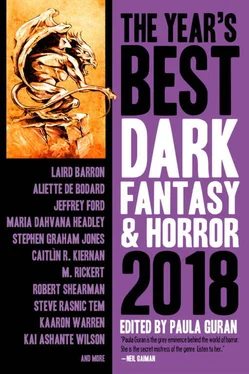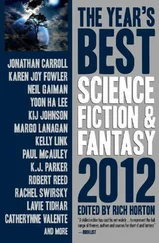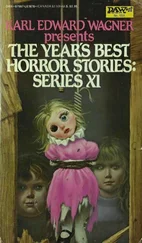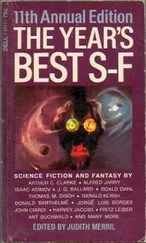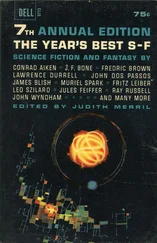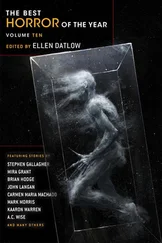(Do such creatures really talk with so much eloquence? Who knows. They do in this story, though.)
“That’s fine,” Sally said, rising to her feet. “You can keep the lights off.”
Thus decided, the two left the basement. Sally followed the thing up the spiral stairwell, her footsteps quiet, its footfalls silent. She followed it into her room and sat down on her bed, quiet as a mouse as the thing began its work. Sally stayed true to her word. She kept it pitch-dark. Not even the glow of the distant town to light their way. Thankfully, her imagination was enough.
When the sound of chewing stopped, when the air was the stink of piss and flayed meat, when there was nothing left to do but leave, Sally got up and walked away.
The thing followed behind.
The next morning, she came back to find her room transformed into a slaughterhouse, the air thick with button-black flies. There was an apology scrawled in her roommate’s blood. Sally had to hide her smile.
“Aren’t you glad you didn’t turn on the lights?”
No, she thought. It would have been fun to watch.
Everything Beautiful is Terrifying
M. Rickert
“But we, when moved by deep feeling, evaporate.”
—Rainer Maria Rilke
The Strangos come all year, identifiable by the clothes they wear, the giggling behind open hands, the wide-eyed pretense of innocence; like belled cats they give their trespass away. I ignore them—for the most part—though recently the baristas have begun giving directions to Laurels tree. They think this is funny, apparently, even if they never witness the punch line. Strangos standing in the middle of Wenkel’s cornfield clutching their little purses. Strangos in the Piggly Wiggly parking lot next to the dumpsters, noses squinched against the stench. Strangos in front of my house—not funny at all—so close to each other the heels of their black shoes touch. I found them early on Christmas morning, standing beneath the streetlamp, upturned faces dotted with flakes of snow, matching pea coats frosted with ice, knees trembling above soggy ankle socks and black shoes.
They arrive all year, undeterred by the season. July and August bring a few carrying guidebooks and taking selfies (which no legitimate Strango would ever do) things get more serious in September, but October is Strango high season. In October the scent of wood smoke mingles with the beeswax candles perfuming my home with honey. Give me that and a blood moon casting everything in a mortal glow. Give me that and the ghost the Strangos seek, though I am not one of them, but an original.
She was buried, they say, in an unmarked grave at her mother’s request. It was generally understood this was done in the usual manner, but after that movie came out with its silly premise that Laurel’s weary ghost haunts the mysterious location of her body’s interment, the Strangos arrived with their earnest obsession. I, myself, seeking answers, once stood on Laurels porch until her mother threatened me with a kettle of boiled water.
“Forgive me?” the Strangos murmur as they pass. It’s just coincidence. The Strangos murmur their forgiveness request because in the movie that’s how it’s done. I stand in white ankle socks and black shoes, clutching the little purse with the clasp that clicks open and shut. Laurel stands beside me, dressed to match; though it’s not really us, of course, but actresses portraying me and her ghost. When I whisper, “forgive me?” she doesn’t say anything. The camera pulls back until we are in a circle of light surrounded by black; then a dot, then nothing at all.
I resisted watching for quite some time until one dreary night, while clicking mindlessly through cooking shows, women-buying-wedding-dresses shows, and fertile-family shows I stopped, stunned, as though experiencing a sudden change in altitude. There she was—Laurel—in her black shoes and white socks, wearing a dress I’d never seen; spinning beneath a bright arc of autumn leaves.
That particular scene comes quite close to the end—as you may know—but it was one of those stations that plays the same movie repeatedly. I can truthfully say that by the third viewing I was eating popcorn again; less enchanted by the Laurel look-alike and more annoyed by what they got wrong, which was almost everything.
Though accused and found not guilty, my innocence was never restored. The Strangos (and the screenplay writer) are convinced I am a murderer but the truth is so much more benign. Ask the Strangos and they will whisper, in sibilant tones, “forgive me?” over and over again until the reporter, either irritated by their petulance, or thrilled to have gotten a good clip for the weird news story gives up trying for more while the photographer waits for that moment when the Strangos open and close their purses making a sound like click beetles.
I am disinclined towards empathy with Strangos, but must confess I understand. Reporters are so annoyingly persistent in asking the wrong questions (as are parents, detectives, attorneys, and everyone) that sometimes a person can find no response more perfect than the defiant sound of purse latch. I did not do it to be annoying or frightening though the movie portrays me as both. I was a child then, accused of murder. I was terrified, not terrifying.
The tree isn’t hard to find, if one knows where to look as, of course, I do. And, while I hate to attribute anything of value to that movie, I must admit after watching it several times I, too, became obsessed with the old oak as a potential location for Laurels ghost. I did not, to be clear, think her mother would have her buried there. I believe she was cremated; her ashes now in Florida.
But her ghost? It seemed possible the tree would make a perfect host. (Like the Caribbean Lagarou tree where people have reported seeing, from a distance, flickering orbs of lights in its branches which, I know, is meant to sound ominous but I find reassuring.) Thus began my October quest through the backyards of my youth to that small hidden field we discovered all those years ago.
When the seasons turned to Halloween we, best friends forever, chose to be twins. The movie would have you believe we dressed alike for years, but in truth it was only a single month, and not even all of that.
When October comes I close the windows, happy to sever any tie with murmuring Strangos. I take out the old photographs: Laurel and me in our bathing suits (not matching) eating popsicles (and in the left corner, beneath the azalea bush the toes of my father’s shoes. He used to like to play that game of spying on us.) Laurel and me on her swing set (there was a time when I was a welcomed guest). Laurel and me in sleeping bags, wide awake, Laurel giving the finger, and me frozen in shock by her bold gesture. I remember how my brother ran to report what she had done and how my mother (still innocent in her own way then) laughed. The last photograph has been widely duplicated—I’m sure you’ve seen it in some fashion or other—Laurel and me in the matching cotton dresses that Mrs. Sheer made in a single weekend. She had extra time on her hands, my mother said, since Laurel was an only child. We are standing in front of my house in those dresses, ankle socks, and white Keds spray-painted black. I can’t remember why we did that. Sometimes too much is made of the casual choices of the young.
My mother found the purses at the dime store and splurged, buying both. I think she felt a little competitive with Mrs. Sheer, though this is pure speculation on my part and, as one who has suffered by what people assume, I try not to guess the motivation of others. My mother bought the purses. They were red. Matching white hairbands completed the look.
I suspect that arranging photographs of Laurel on the mantel might seem macabre to others. I can’t be sure about what “normal” people think; they got everything so wrong with me that I have never adjusted to their ways. Halloween has, by necessity, evolved over the years into my own manner of celebration. Not for me the freedom of cheap costumes and pillowcases full of candy. That was lost with Laurel’s death; first to my grief, then to my shame, and finally to my compromised life. While others were content with false ghosts, I hoped for the real thing. To be forgiven. Not for a murder I never committed, but for leaving her where she was later found with dirt and skin beneath her fingernails.
Читать дальше
